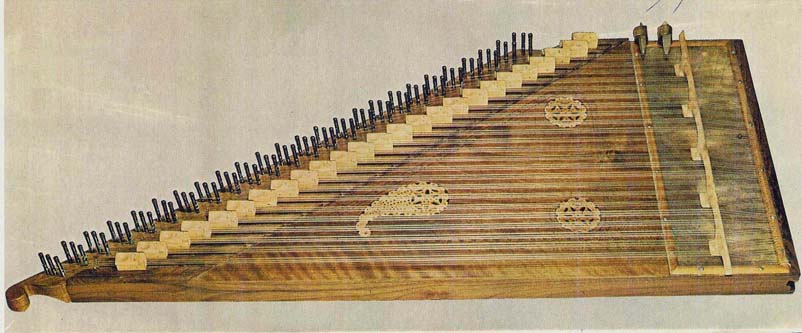RECORDED MUSIC
I chose to designate my compostions (between 1976 and 1981) as Recorded Music, as they stand between musique concrète and instrumental music. I began with recording instrumental improvisations, subsequently edited and somewhat ‘amplified’, while preserving the spirit and basic form of the original improvisation. Whereas followers of musique concrète often used recorded sounds as raw materials, submitted to drastic electronic transformations, I use electronic means sparingly, obtaining sound variety by new instrumental techniques. Thus the sense of direct touch with the instrument is preserved, though the final result is far removed from its ‘normal’ sound, often making impossible to guess what instruments have been used.
The first group of works was played on the Qanun, an Arab zither-like instrument, which I used with a different technique from the tradional one. Each of the following Qanun pieces aims to achieve a different sound character out of an instrument of apparently modest sound possibilities.
Instead of the open-strings of the qanun, I used only stopped strings. The resulting pitch is unstable and unpredictable, making it impossible to write down, or even repeat, the music. The only means to keep control on the overall form, is by recording and editing. Composing in this way feels sometimes like trying to create a stable sculpture from a liquid material.
1. TOCCATA – a multi-sectioned work, not unlike the Baroque genre, with an emphasis on melody, all its sections being speech-like, measure-free and ‘pitch-free’.
2. LEIERMAN II – the title refers to Schubert’s famous song, with the thought what might have happened to Schubert’s poor street musician if he had to grind his organ (or some local instrument) in the scorching summer heat of the Middle East. Leiermann II
3. OVERTURE – although its sonorities evoke a wind instruments, or an organ, this is actually a ‘piano piece’, where all sound attacks have been softened down, thus eliminating the percussive element of the piano. Overture-033
4. ALTERNATIVO, or SEQUEL to OVERTURE – the first sound of the Overture served as the starting point of the present piece, with the piano, treated here not unlike the qanun in the former pieces serving as the as the main sound source. Some other materials are added, such as an Indian sitar or electronic sounds triggered by the piano, their rhythms being thus ‘organically’ related to the piano sounds.
5. O.R.M – is based on a duo-improvisation with Yossi Gutmann. The source here is an electric organ, which I played, while my partner could modify the result through a ring-modulator and an oscilator. While he could not produce any sound of his own (or predict what I was going to do), I was totally dependent on his actions for the final result. Still, we finally got a closed form, beginning and ending on an almost ‘classic’ D minor, with some surprises in between.
ORM-B-044
Yossi Gutmann and Ido Abravaya,
RECITATIVO & ARIA FOR VIOLA POMPOSA AND CONTINUO
A shared composition, based on a shared improvisation. The ‘baroque’ title can hardly conceal an impossible wild dialog of two obsolete/ nonexistant instruments. The ‘pomposa’ part was substituted with a violino terribilmente scordato, while the ‘continuo was delivered by an equally (deliberately and permanently) mistuned qanun. We hope that the somewhat wild outcome still justifies the learned caption.
